► New EV challenger promises new benchmarks
► 517-mile driving range, super-fast charging
► On sale in 2021, you can place a deposit now
Buckle your seatbelts, folks, because this is going to be quite a ride. Meet the Lucid Air, a brand new ‘post-luxury’ electric car from a company lead by the chief engineer of the Tesla Model S and so packed with astounding promises we almost don’t know where to begin.
Whether you want organ-flattening performance, outstanding range, faster charging or simply more space, the Lucid Air is making bold claims – and it’s managing to do so while looking modern and special but not entirely alienating. Prices are set to start at under $80,000 (around £62,000) and it goes on sale in 2021 with as much as 1080bhp.
Lucid Motors, you have our attention…
Sorry – how many horsepower?
You read that right – 1080bhp will be available from the top-spec dual-motor version, which is of course also four-wheel drive. That’s enough power to ‘consistently’ (no dig at Tesla there at all, honest) do quarter-mile sprints in 9.9 seconds. No other electric saloon has yet done the quarter in under 10 seconds.

That’s probably enough info to tell you Lucid Motors is an American firm – California-based, to be precise; perhaps more useful to us is that it will do 0-60mph in 2.5 seconds. You can probably also guess that the $80k version won’t have that much performance. In fact, Lucid hasn’t revealed the details of that basic Air variant, as that’s not planned for sale until 2022.
But as well as the 1,080bhp Air Dream Edition, which will only be available in limited numbers at a price of $169,000 (approximately £130,000), 2021 will also see the launch of 620bhp Air Touring and the 800bhp Air Grand Touring, priced $95,000 and $139,000, respectively (£73k and £107k at current exchange rates).
These models reckon 0-60mph in 3.2 and 3.0 seconds, and minimum top speed is 155mph; the more powerful Grand Touring and Dream Edition peak at 168mph. The raw performance of the Lucid Air is really second fiddle to some of its other attributes, however.
What makes this different to a Tesla?
The CEO and CTO of Lucid Motors is Peter Rawlinson, who was also the chief engineer for the Tesla Model S. He speaks of the Air as being a ‘halo car for the entire industry, one which shows the advancements that are possible by pushing the boundaries of EV technology and performance to new levels.’
What does that mean? Much of it is related to the ‘Lucid Space Concept’, a ‘revolutionary approach to packaging’ that uses the ‘miniaturization’ of the drivetrain components within a skateboard-style chassis called the Lucid Electric Advanced Platform (yes, LEAP…) to maximise passenger and luggage space.
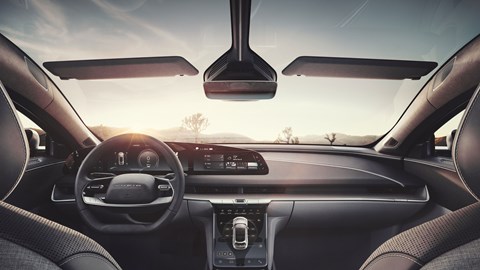
All of the Lucid Air’s drivetrain components are developed in-house, which means the motors are smaller yet more powerful than those used by rivals. Lucid also claims the ‘race proven’ battery-pack technology is also far more compact than we’ve seen before.
So the Air is able to store as much 113kWh of juice onboard while offering loads of interior room and 739 litres of luggage capacity, split between a conventional boot and a 280-litre frunk ahead of the passenger cell.
That’s a lot of battery – what’s the driving range?
The 800bhp Air Grand Touring is the sweet spot, with an American EPA driving range guide of 517 miles per charge.

The Air Touring falls back to 406 miles (smaller battery pack to save weight), while the Air Dream Edition will do 503 miles on 19-inch wheels, or 465 miles on the 21s it actually comes with.
WLTP might slap those figures around a bit, but the Lucid Air is certainly looking to move the electric game on, especially as it is also promising class-leading charging times.
How quick is it to charge, then?
Lucid Motors claims the Air will be the world’s fastest charging EV. Connected to an appropriate DC fast charger, it can gain as much as 20 miles per minute, thanks to the slightly hilarious ‘1200mph’ peak charging speed capability.
Fast enough that 20 minutes plugged in will give you 300 miles of driving. To us, that finally looks like decent coffee break capacity.
What about the design?
The exterior is futuristic but not outlandish – different enough to make people stare, but not point and laugh. You’ve got to hope the climate control is up to the task, though, as the roof is one large glass canopy.
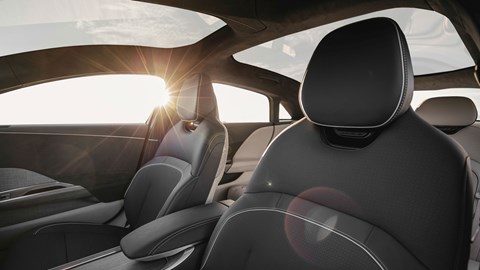
Also notable on the outside are the headlights, which use a ‘Micro Lens Array’ comprised of ‘thousands’ of light channels that can be digitally adjusted to provide incredibly precise lighting. Wouldn’t want to be the software engineer in charge of that project.
Whatever you think of the way it looks, the Air does have one other trick up its sleeve – or maybe in its frunk – with a drag coefficient of 0.21Cd it’s also said to be the world’s most aerodynamic luxury car. Which will help with the real-world driving range and performance.
Is it just as trippy on the inside?
On the inside there’s an inevitably minimalist but high-tech approach. The instrument cluster is a vast 34-inch ‘Glass Cockpit’ digital display with 5k resolution that curves around in front of the driver, and there’s a secondary central ‘Pilot Panel’ display that can be tucked away in the centre console to reveal a large storage cubby.
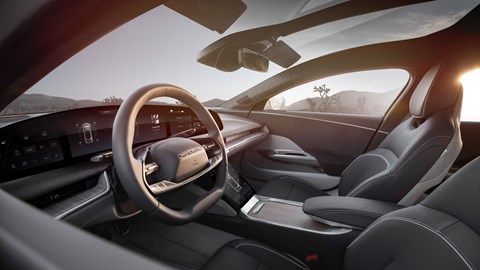
Lucid Motors is at pains to point out that there are still physical controls on the steering wheel and for the climate settings, milled from aluminium.
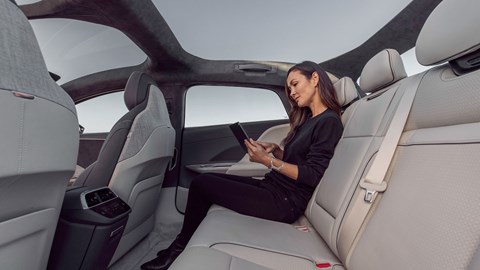
Passenger room is graded as ‘luxury class’ while the car is supposedly sized like a sports saloon – just look at all that rear legroom.
Any other high-tech tricks?
There’s another creeping sense of inevitability about the advanced driver assistance (ADAS) tech, which is said to include ‘the most comprehensive sensor suite on the market’ – 32 in all, including cameras, radar, ultrasonics and an EV world-first high-resolution lidar system.
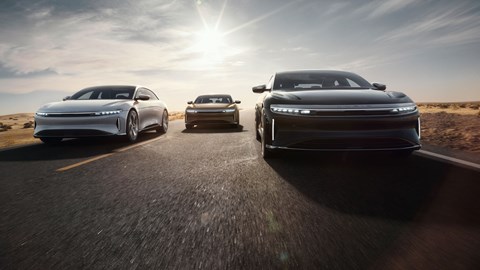
There’s also a driver monitoring system (DMS) and HD mapping with geofencing capability. It’ll cope fine with Level 2 and Level 3 autonomy.
Finally, the Air also has fully integrated Amazon Alexa for voice control, which will do everything from smart home stuff to navigation and streaming media – not to mention essential on-the-go shopping and in-car climate-control functions.
When can I actually buy one?
UK reservations for the Lucid Air are open already, if you’re prepared to put down a £770 refundable deposit. Production is set to start in Lucid’s Arizona factory imminently, with the first North American customers due to receive their cars in Spring 2021.
How much of all this should we really believe?
The proof will be in the final production version and the driving, but if the technology is as good as Lucid says it is, there doesn’t seem to be too much reason to doubt the claims it makes. We know electric motors have huge potential for power, and battery tech is starting to gain momentum now.
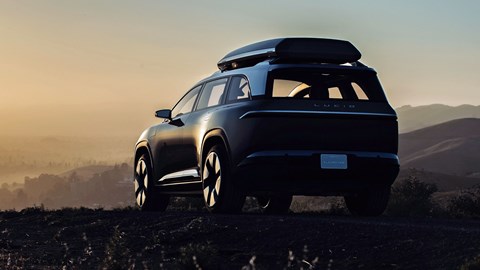
What’s more, the Air is just the first of more planned Lucid Motors electric cars. The firm is already teasing an incoming SUV, currently known as Project Gravity and based on the same LEAP architecture as the Air. This is scheduled to go on sale in 2023.